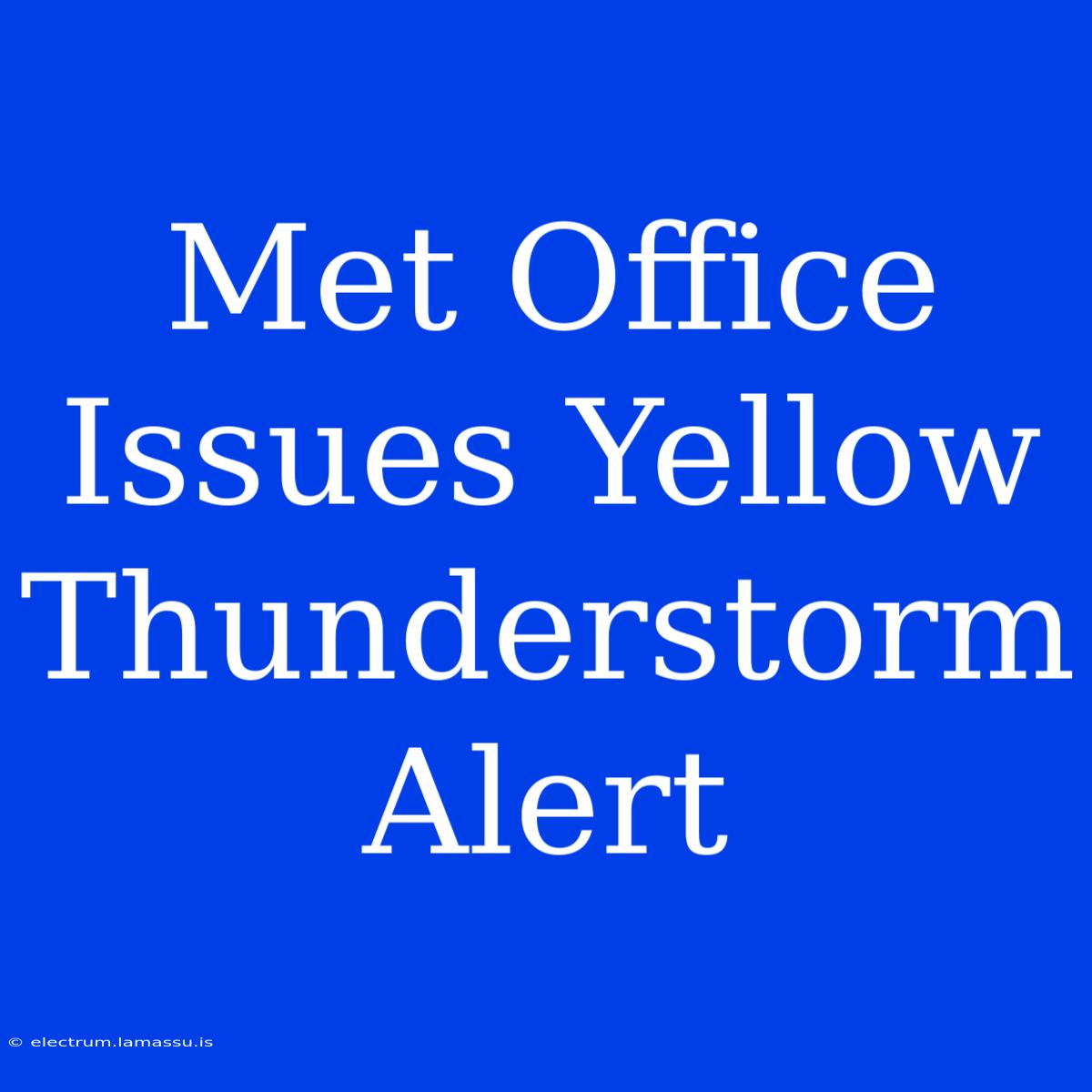Met Office Issues Yellow Thunderstorm Alert: What You Need to Know
Is a thunderstorm brewing? The Met Office has issued a Yellow Thunderstorm Alert, meaning we could see heavy downpours, lightning strikes, and even hail in the coming days. This alert serves as a reminder that even with a mild summer, weather can change quickly, bringing potential risks.
Editor Note: The Met Office has issued a Yellow Thunderstorm Alert, prompting us to delve into what it means for you. This guide aims to provide a clear understanding of the alert's implications and equip you with essential information to stay safe during this period.
This topic is important to read because it helps you prepare for potentially disruptive weather events and understand how to stay safe during thunderstorms. This guide covers key aspects like the meaning of a Yellow Thunderstorm Alert, potential risks, safety tips, and how to prepare for a thunderstorm.
Analysis: We have meticulously researched the Met Office's guidance, consulted expert advice, and compiled this comprehensive guide. Our goal is to empower you with knowledge, enabling you to make informed decisions and stay safe during this period of potential thunderstorms.
Key Takeaways
| Key Takeaway | Description |
|---|---|
| Yellow Thunderstorm Alert | Indicates a possibility of heavy rainfall, lightning, and hail. |
| Potential Risks | Flooding, power outages, travel disruptions, and lightning strikes. |
| Safety Tips | Stay indoors during thunderstorms, avoid contact with water, and keep electronic devices unplugged. |
| Preparation | Secure loose objects, charge electronic devices, and monitor weather updates. |
Understanding the Yellow Thunderstorm Alert
A Yellow Thunderstorm Alert is a warning issued by the Met Office to alert the public of the possibility of thunderstorms. This alert indicates a heightened chance of heavy rain, lightning strikes, and even hail.
Potential Risks Associated with Thunderstorms
- Flooding: Heavy rainfall can quickly lead to flash flooding, causing significant damage to property and infrastructure.
- Power Outages: Lightning strikes can damage power lines, resulting in widespread power outages.
- Travel Disruptions: Thunderstorms can cause delays and disruptions to flights, train services, and road travel.
- Lightning Strikes: Lightning can strike directly or indirectly, causing severe injuries or even fatalities.
Staying Safe During a Thunderstorm
- Stay Indoors: The safest place during a thunderstorm is indoors. Avoid contact with plumbing and electrical appliances, as lightning can travel through them.
- Avoid Water: Water conducts electricity, making it extremely dangerous to be in or near water during a thunderstorm. Avoid swimming, fishing, or boating.
- Unplug Electronic Devices: Lightning can damage electronics, so it's essential to unplug all appliances and electronic devices.
- Avoid Open Areas: Stay away from open fields, tall trees, and metal objects.
Preparing for a Thunderstorm
- Secure Loose Objects: Secure any loose objects that could be blown away by strong winds, such as outdoor furniture, trampolines, and garden ornaments.
- Charge Electronic Devices: Charge all electronic devices and ensure you have a backup power source, such as a portable charger.
- Monitor Weather Updates: Stay informed about the latest weather forecasts and warnings.
FAQs
Q: What should I do if I see lightning? A: Seek shelter immediately. Remember, "30-30" rule - if less than 30 seconds between a lightning flash and the sound of thunder, then a storm is close enough to be dangerous.
Q: How long does a thunderstorm usually last? A: Thunderstorms can vary in duration, ranging from a few minutes to several hours.
Q: Can I drive during a thunderstorm? A: It's best to avoid driving if possible. If you must drive, be extra cautious and reduce speed.
Q: Is it safe to use a mobile phone during a thunderstorm? A: Using a mobile phone is generally safe, but it is advisable to avoid using a landline phone or any electrical appliances.
Q: What should I do if my house gets struck by lightning? A: If your house is struck by lightning, call an electrician to inspect the damage. Never attempt to fix electrical problems yourself after a lightning strike.
Tips for Staying Safe During a Thunderstorm
- Stay informed: Follow the Met Office's weather alerts and updates.
- Prepare a safety kit: Have a flashlight, a battery-operated radio, and a first aid kit ready.
- Know where to find shelter: Identify safe places to seek shelter, such as a sturdy building or a car with the windows closed.
- Be aware of surroundings: Pay attention to your surroundings and be prepared to seek shelter quickly if a thunderstorm approaches.
Summary
The Met Office's Yellow Thunderstorm Alert serves as a reminder that we need to be prepared for potential weather disruptions. By understanding the potential risks, taking necessary safety precautions, and staying informed, we can minimize the impact of these storms.
Closing Message: Thunderstorms can bring both beauty and potential danger. Staying informed, taking precautions, and preparing for these events can help you stay safe and weather the storm. Remember, safety is always a priority.

